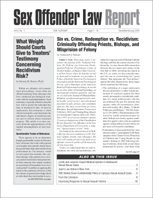What Studies of Brain Imaging and Behavior Suggest About Sex Offender Treatment Modalities
Author: Ivonne Arias.
Source: Volume 20, Number 01, December/January 2019 , pp.1-7(7)

next article > |return to table of contents
Abstract:
Brain imaging techniques have advanced the understanding of various disorders and brain structure abnormalities, including those of individuals engaging in sexual misconduct. Brain anatomy associated with abnormalities in sex offenders has been studied using imaging techniques such as magnetic resonance imaging (MRI), functional magnetic resonance imaging (fMRI), and diffusion tensor imaging (DTI). Using this technology, studies have found neuropsychological deviances in sex offenders, as well as other personality and interpersonal traits that contribute to their criminal conduct. Brain imaging instruments allow researchers to identify abnormalities in neuronal pathways and brain structure, and, when combined with relevant psychological inventories, such as the Psychopathy Checklist-Revised (PCL-R), this information is useful when evaluating what treatment modalities are most appropriate for prevention and reducing recidivism rates.Keywords: Role of Prefrontal Cortex in Psychopathy and Pathophysiology
Affiliations:
1: University of California, San Diego.